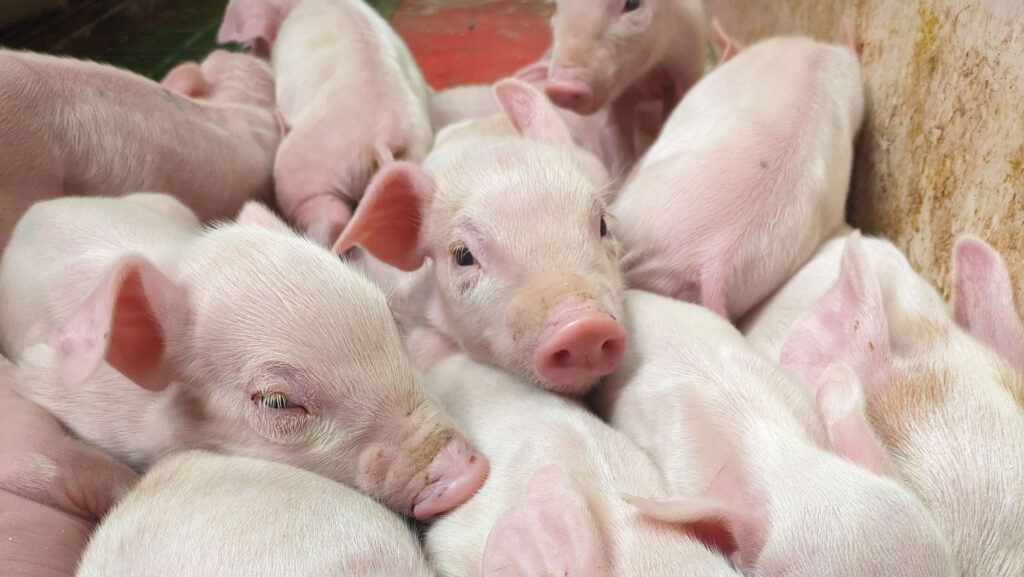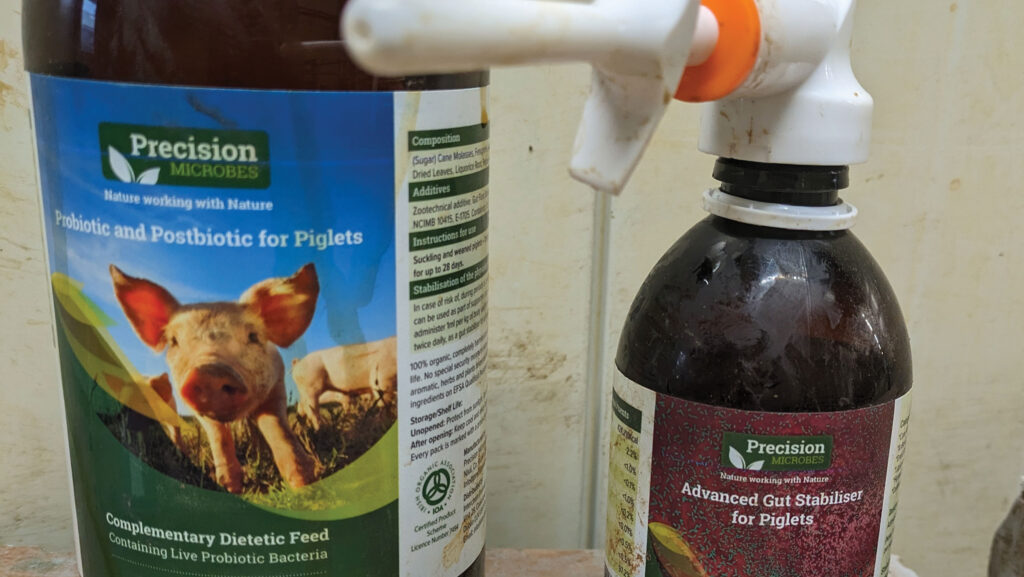Irish trial shows benefits of microbes for piglet gut health
 © Keith O'Mahony
© Keith O'Mahony Feeding piglets microbes from birth to support gut health can reduce scours, lower routine antibiotics use and improve average daily gain, research carried out at a commercial pig farm in Ireland has shown.
University College Dublin (UCD) undergraduate Keith O’Mahony undertook the study while on placement with McAuliffe Pig Farms, County Kerry.
See also: 7 ways to encourage a healthy gut microbiome in pigs
Farm Facts
McAuliffe Pig Farms, County Kerry
- 1,000-sow farrow-to-finish-unit
- 600-sow unit
- 400-sow farrow-to-finish-unit
- Finishing unit
Shane McAuliffe runs 2,000 sows across four units. The trial took place on his enterprise’s largest unit – a 1,000-sow-to-finish operation.
Shane says he wanted to see how the beneficial bacteria in Dublin-based company Precision Microbes’ formulation could improve gut health and lower routine antibiotics use.
“Over the years, we have placed a big focus on improved gut health through numerous different research trials, and that has been key to maintaining our high health status and having no routine use of antimicrobials,” he says.
About the trial
At farrowing, 661 piglets, born from 42 sows, were assigned to one of three groups:
- A control group of 220 piglets was not given any treatment
- A group of 220 was given Precision Microbes’ Advanced Gut Stabiliser for Piglets (AGS) at birth and offered the company’s Probiotic and Postbiotic for Piglets (PP) via water for seven days
- A third treatment group of 220 was also administered AGS at birth, but stayed on PP until 28 days of age.
“This allowed us to compare the short- and medium-term supplementation of the products,” explains Keith.
On average, from the 42 litters recorded as part of the trial, each sow produced 15.5 live piglets.
Piglets were given one dose of AGS orally at birth via a syringe (2ml a piglet). PP was administered via drinking water for the first 20 days. At day 21, it was mixed into the feed.
As intakes increased, the quantity of PP increased week by week (see Dose rate of Probiotic and Postbiotic for Piglets).
Results
Piglets were weighed at birth and were re-weighed at three and four weeks of age.
Keith says there was a positive increase in the average daily liveweight gain (DLWG) of piglets within treatment groups two and three.
“Implementing AGS and PP for seven days led to an increase [in average DLWG] of 37.8g, which is an increase of 16.2% between the control group and two treatment groups.”
At 40.48g, piglets in group three showed an 18.16% increase in average DLWG compared with the treatment group (see Results).
He says there was a minor difference in DLWG between groups two and three. However, he suggests this was because the trial only ran for four weeks, and the piglets did not spend sufficient time on treatment three to obtain adequate results.
“The first farrowing was recorded on 11 January and the last was 10 days later. By week four, at the time of reweighing, the average piglet age was just 15-18 days old,” he explains.
Scouring incidence
The trial revealed an 80% reduction in scours in groups two and three when AGS and PP were administered.
As a direct consequence of reduced scouring, antibiotics use was non-existent in the treatment groups.
Keith explains: “In the control group, we treated four litters (78 piglets) with antibiotics, while no antibiotics were administered to any litters within groups two or three.”

Challenges and cost
Keith says the biggest challenge was to encourage the intake of water, and the method of administration made it impossible to measure PP intakes accurately.
“Some litters were noted to consistently finish the daily offering of PP. However, most litters did not finish half of what was offered daily,” he estimates.
Tommy Heffernan, veterinary consultant for Precision Microbes, says water would be the least favoured way to administer the product because water intake cannot be controlled.
This also meant the dose rate had to be increased.
“When PM is fed in creep feed, the dose rate used is 8-10ml/kg of dry feed. This is the feed rate on farms where long-term feeding daily is being undertaken.
“A young piglet on creep will only pick at the start, so the feed dose rate will be lower. However, this goes up as consumption increases,” explains Tommy.
The preferred way to administer the product is via feed, he says.
The company has made a machine that uses a spray nozzle to dose feed accurately while it is inside a hopper on the farm.
Although doing this at the mill would save time, it must be done on farm because of the nature of the liquid.
“We are using a live product, so we have to devise ways of dosing on the farm,” explains Tommy.
PP costs £10/litre. Returns are largely driven by the farm’s performance and antibiotics use and will vary from farm to farm, he says.
Zinc removal
Scour remains one of the leading causes of high antibiotics use on farms, says Tommy Heffernan, veterinary consultant for Precision Microbes.
“One of the biggest challenges we see on pig farms is E coli. Coliform bacteria double every 20 minutes, so within six hours, three coliforms can turn into 340m coliforms,” he says.
Zinc oxide was commonly used to reduce diarrhoea in post-weaned pigs; however, authorisation for therapeutic use in the EU was withdrawn in 2022, and this ruling formed part of retained EU law in the UK.
Zinc is antimicrobial but also may inhibit good bacteria. By comparison, Advanced Gut Stabiliser contains a unique prebiotic that competes with E coli bacteria (rather than killing it) and stimulates the development of natural gut flora, he explains.
Although zinc was not the focus of the trial at McAuliffe Farms, another trial at Robert Dowley’s 500-sow farm in County Kilkenny has shown that feeding microbes can help when zinc is removed from the diet.
In this trial, born-alive rates were up 0.28 pigs a sow, and piglet transfer and weaning weights were 1.59kg and 0.55kg higher, respectively, when sows had been fed a probiotic and postbiotic from Precision Microbes via their liquid feed.
About Precision Microbes and Advanced Gut Stabiliser
- Advanced Gut Stabiliser contains pre-, pro- and postbiotics for young pigs and includes a blend of Lactobacillus (beneficial) bacteria. It is designed as a one-shot dose to kick-start gut health.
- Probiotic and Postbiotic for Piglets is a fermented liquid containing Enterococcus faecium NCIMB10415.
Daily dose rate of Probiotic and Postbiotic for Piglets |
|
|
Week one |
2.5ml per piglet |
|
Week two |
4ml |
|
Week three |
5.5ml |
|
Week four |
7ml |
Results |
|||
|
|
Treatment group 1 |
Treatment group 2 |
Treatment group 3 |
|
Average birthweight (kg) a piglet a litter |
1.3 |
1.3 |
1.3 |
|
Average daily liveweight gain (DLWG) at week four (g) |
222.96 |
260.78 |
263.44 |
|
Difference in average DLWG compared with control group (g) |
|
+ 37.82 |
+40.48 |
|
Difference in average DLWG compared with control (%) |
16.9 |
18.16 |
|
|
Scour incidence (%) |
35.70 |
7.14 |
7.14 |
|
Antibiotics use (piglets) |
78 |
0 |
0 |

